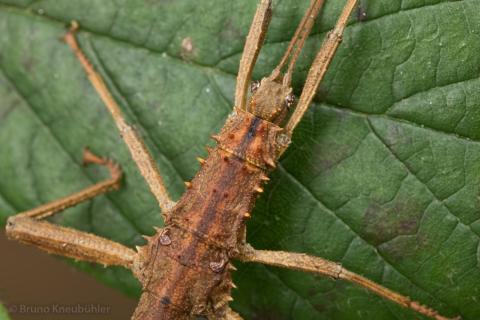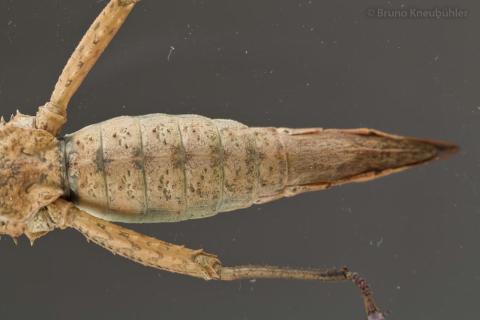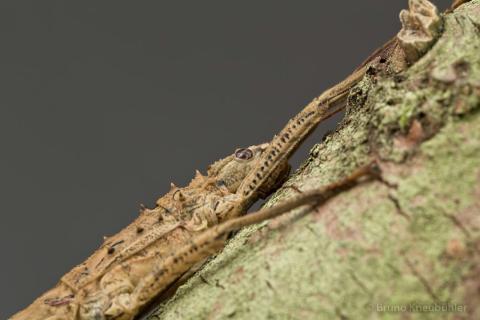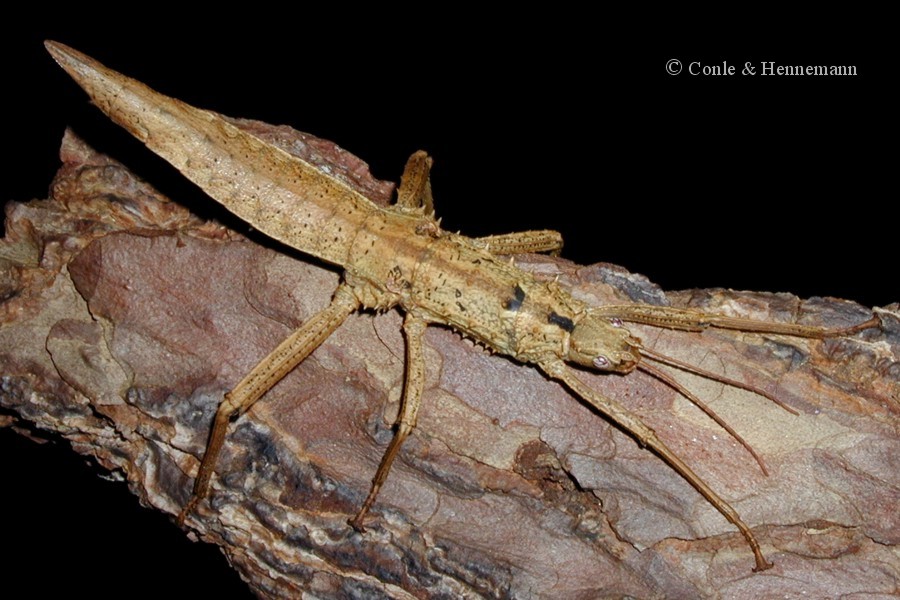
Genus
Species
Stock
CLP
183
PSG
261
Culture status
Unknown
Foodplants
Bramble (Rubus spp.)
Hazel (Corylus avellana)
Cherry Laurel (Prunus laurocerasus)
Beech (Fagus sylvatica)
Salal (Gaultheria shallon)
Breeding notes
(by Bruno Kneubuehler)
_________________
General Notes
- Etymology
Canachus was a greek sculptor of Sicyon in Corinthia.
And alligator is an anglicized form of el lagarto, the Spanish term for "lizard", which early Spanish explorers and settlers in Florida called the alligator. It seems that Redtenbacher (or rather Stål in 1875) has seen some sort of distant similarity between Canachus and these armoured reptiles - The genus Canachus has been set up by Stål in 1875 and it includes 5 accepted species (Nov. 2012). The type species is C. crocodilus Stål, 1875. The author of this care sheets knows about at least another new, quite spiny species from nothern New Caledonia (which is not in culture) – of which you can find here a photo:
http://images.phasmatodea.com/-/313/-/-/ - recent in-depth genetic studies (Bradley et al. 2009) have shown that Canachus are not closely related to Eurycantha, which makes it questionable that they belong into the same tribe or even the same subfamily. Therefore future revisions of the subfamily Eurycanthinae will most probably come up with corresponding taxonomic changes
_________________
Culture History
- 2002 – since then in continuous culture in Europe
_________________
Origin
- Mt. Koghis, New Caledonia
_________________
Females
- very sturdy and stocky phasmids
- about 7.5 – 8.5 cm long
- females are among each other very similarly colored
- body (ventrally, dorsally) and legs brown
- body and legs with many irregularly shaped, bigger and smaller dark-brown to black dots
- lateral abdominal side light brown
- adult females of this species have typically a dark, centered stripe dorsally on the prothorax
- 2 bigger spines on the head
- numerous spines on the thorax (mainly dorsally) and legs (mainly hindlegs)
- fainly reddish, small hindwing buds are visible
- antennae shorter than forelegs
- a „ovipositor“, composed of the strongly elongated subgenital and supraanal plates
_________________
Males
- stocky phasmids too
- about 5 cm long
- males among each other are very similarly colored
- mottled with different brown shades
- dorsal thorax area is reddish-brown with a darker midline
- a dark, centered stripe on the dorsal prothorax
- numerous bigger and smaller spines on the head and thorax (mainly dorsally)
- small spines on the legs
- body strongly granulated
- clearly visible hindwig buds, them membranous part of which (inner side) is brightly pink
- antennae shorter than forelegs
_________________
Nymphs
- about 19 mm (L1)
- sturdy nymphs
- short antennae
- by L3 it is quite easy to draw a distinction between ♀♂ (by the naked eye), as the supraanal plate is already a bit enlongated in females
_________________
Eggs
- about 7 x 4 mm
- barrel-shaped
- brown or almost white (when freshly laid)
- surface slightly granulated
- matt
- no capitulum present on the operculum (egg lid)
- micropylar plate and micropylar pore distinct and clearly visible
_________________
Food Plants
- this is a very polyphagous species and thus easy to feed
- bramble (Rubus spp.)
is very well accepted by freshly hatched nymphs, older nymphs and adults. But they don't like the fresh bramble leaves in spring ! - hazelnut (Corylus avellana)
is very well accepted by older nymphs and adults (not tested with freshly hatched nymphs) - cherry laurel (Prunus laurocerasus)
is very well accepted by older nymphs and adults (not tested with freshly hatched nymphs). But due to the high contect of hydrogen cyanide in the leaves of this plant, it is not yet sure whether it is a good sole food plant - european beech (Fagus sylvatica)
is very well accepted by older nymphs and adults (not tested with freshly hatched nymphs) - Salal (Gaultheria shallon)
is very well accepted by older nymphs and adults (not tested with freshly hatched nymphs) - most probably a wide variety of other plants is also accepted
_________________
Behaviour
- nymphs as well as adults hide themselves during the day and remain passiv
- dark spots (e.g. behind bark or similar things) and leaves on the floor are well accepted hiding places. Attention – such places in a cage tend to get mouldy rather quickly
- shortly after dawn they become active (especially the nymphs) and start crawling about and feeding
- nymphs and adults usually freeze up when they feel threatened. But some individuals also try to crawl away from danger, but just for a few steps
- if adult males feel very threatened, then they may display their tiny hind wings so that the brightly pink colored analregion becomes visible.
- It seems that males stay for some time with the same female
- females use their „ovipositor“ to lay eggs into the ground. I use dry sand, from which it is very easy to sieve out the eggs every week
- older nymphs and adults have the rather annoying peculiarity that they bite through the leave stems. Therefore one will often find the food plants defoliated quickly. But if the cage is not too big, then they will also feed on the leaves on the floor, whch do not dry up quickly due to the high humidity in the cage. It is not clear whether this behaviour is of any significant advantage – or if they just like the stems more than the leaves. It has been suggested that they do this „on purpose“ in order to create hiding places on the ground. But personally I do not belive this, because I do not grant them such an adavanced cognitive ability. Also I could not observe that this behaviour stops when the cage floor is already covered with leaves
_________________
Developement
- incubation time (HH-incubation on slightly damp sand at 20 - 23 °C) is about 4 - 5 months
- eggs can be placed on the sand, it is not necessary to rebury the eggs
- spread some dried (!) moss over the eggs - this will make it much easier for the nymphs to hatch unscathed and it also reduces mould growth to some extend
- hatching ratio is very high (> 50%)
- males will be adult after about 4 – 5 months (at 20 – 23°C), females after about 6 – 8 months
- females start laying eggs after about 5 weeks
- compared to other phasmid species, females of C. alligator lay rather few eggs during their whole life. Different sources mention about 50 – 70 eggs
- every few weeks they lay a clutch of eggs, with 2 – 8 eggs per clutch
- the avarage is about 15 eggs per female and month
- adult females can live up to one year, males have a shorter span of life
_________________
Breeding Notes
- my general notes on how to breed phasmids are an integral part of this care sheet
- it is very easy to breed this species
- as the freshly hatched nymphs are already quite big, therefore the incubation container should be big enough
- it is better to keep small nymphs separat from the adults
- keep the nymphs in a cage with a raised humidity
- a constantly wet paper towel on the floor of the cage helps raising humidity
- a humidity level of about 70+ % rH (for adults) and 80+ % rH (for nymphs) seems to be fine
- nymphs and adults can be kept in a Faunabox (or similar cages like Faunarium)
- move nymphs to a bigger cage as they grow bigger
- a cage of 20 x 20 x 20 cm is big enough for 3 adult couples of this species (or considerably larger if the cage also contains other species !)
- generally I advise to keep different phasmid species seperately (unfortunately, overcrowed cages are still too common)
- I have never sprayed nymphs, adults or their cage with water
- even in rather small and crowed cages moulting seem to be no problem
_________________
References
- Phasmida Species Files (www.phasmida.orthoptera.org)
- Buckley, T.R., D. Attanayake, and S. Bradler. 2009. Extreme convergence in stick insect evolution: phylogenetic placement of the Lord Howe Island tree lobster, Proceedings of the Royal Society B, 276: 1055-1062.
- Emmanuel Delfosse, Paris (personal communication)
- Daniel Ballmer, Schweiz (personal communication)
